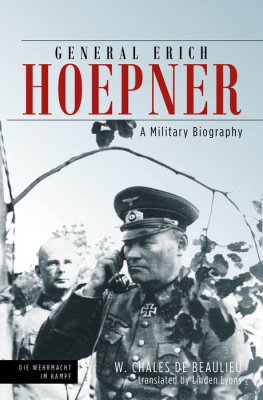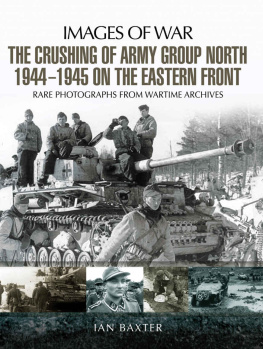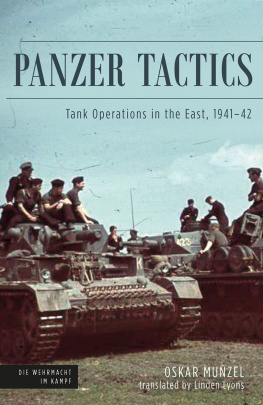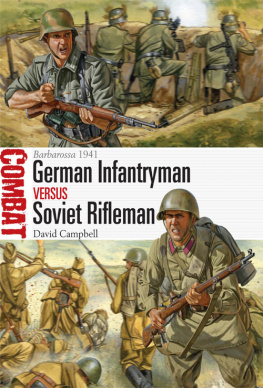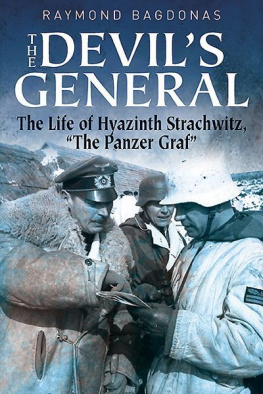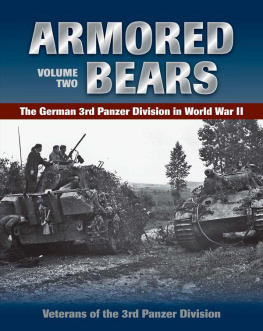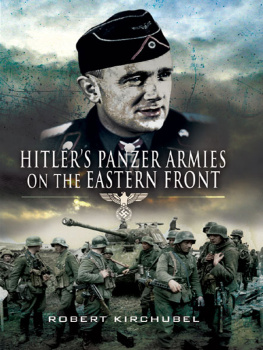This book is dedicated to the memory of the highly respected Colonel-General Erich Hoepner by his chief of staff .
Foreword
The war on the Eastern Front between 1941 and 1945 was the bloodiest theatre of war of the bloodiest war in history. And yet, the knowledge of this cataclysmic struggle between two evil regimes is often confined to a handful of events, campaigns and battles. Everybody has heard of Stalingrad, Kursk and the battle for Moscow. Other events are often overlooked. Operation Barbarossa , the initial German invasion of the Soviet Union in 1941, is one of the near-forgotten episodes in this war. Perhaps the reason for this is that, from a distance, the advance seemed to be perfectly planned and executed by the Germans. Like a knife through hot butter the Germans pushed through the Soviet lines and gained vast stretches of Soviet territory, before the exhausted German troops, suffering from the cold Russian winter, were finally stopped at the gates of Moscow and Leningrad. So the story goes. However, the reality was different, and, despite the seemingly easy German victories over numerically vastly superior Soviet forces, the Germans encountered problems from an early stage.
This book tells the story of Panzer Group 4, which formed part of Army Group North and whose task it was to reach Leningrad, the second city of the Soviet Union. The author of this book, Walter Chales de Beaulieu, was born in Saalfeld in 1898. He joined the Prussian artillery as an ensign in 1915 and served on the Eastern Front between December 1915 and December 1916. His unit was stationed in the area of Dnaburg, in modern-day Latvia. He was thus familiar with the area through which the German Army Group North advanced in the summer of 1941. From 1916 to 1918 he fought on the Western Front and continued to serve in the army after Germanys surrender. In the inter-war period, he was trained as a general staff officer. This was in breach of the Versailles Treaty, but it showed his great military skills and determination. When the Germans invaded the Soviet Union in June 1941, Chales de Beaulieu, holding the rank of full Colonel, served as Chief of Staff of Panzer Group 4. Later, he commanded the 168th and 23rd Infantry Divisions on the Eastern Front, the latter again in the area that Army Group North had conquered in 1941. On 12 September 1944, Chales de Beaulieu was transferred to the Fhrerreserve (the reserve of leaders) and was finally discharged from the army on 31 January 1945. The main reason for this was that Chales de Beaulieu was no longer seen as politically reliable by the Nazi regime considering that he had served as Chief of Staff to the commanding officer of Panzer Group 4, Generaloberst Erich Hoepner. Hoepner had been dishonourably discharged from the Wehrmacht in 1942 and had been one of protagonists of the failed putsch to kill Hitler on 20 July 1944.
Despite his fate in the Third Reich, it is interesting to note that Chales de Beaulieu did not solely blame Hitler for the failure of Barbarossa and the difficulties that Panzer Group 4 encountered during the advance into the Soviet Union. Chales de Beaulieu published his book in German in 1961 and this was the time when numerous apologetic studies, autobiographies and the like were published by former German generals. The usual theme of these publications was that the Wehrmacht had fought honourably and that Hitler was solely to blame for the defeat of Germany. The operational masterminds of the German general staff had been defeated not by the enemy, but by the strategic dilettantism of Hitler. Chales de Beaulieus book stands out from this general and incorrect theme. With the clear and analytical view of a general staff officer, he describes the challenges and problems that the Wehrmacht had to face against the Soviet Union right from the beginning: a poor road network, supply issues and a general lack of troops to first conquer and then control the Soviet territory. He also points out that the Soviet military leadership was poor, but that the Soviet soldiers fought bravely. In 1961, the Cold War could have turned hot very easily and this would have resulted in a clash of NATO and Warsaw Pact troops. In a nearly textbook fashion, Chales de Beaulieu presents his operational lessons from the war in the East lessons that would be useful in a conventional clash of Titans in the 1960s. He stresses the importance of the element of surprise, command and control, supply, and the necessity for a joint Army and Air Force conduct of battles and operations. These points are as relevant today as they were in 1961 or 1941. Therefore, this book does not only offer an unusually frank assessment of the German situation in 1941, but it also offers an insight into the character and also the unchanging nature of war.
Dr Matthias Strohn, M.St., FRHistS
Head of Historical Analysis,
Centre for Historical Analysis and Conflict Research, Camberley
Senior Lecturer,
Royal Military Academy Sandhurst
Reader in Modern War Studies,
University of Buckingham
Introduction
The events described in this book are portrayed in the way they were seen and experienced by the command element of Panzer Group 4. The description is based on original records and documents (war diary, orders, reports, situation reports, etc.). This goes also for the description of the views and assessments of the leadership of the panzer group. No changes or additions have been made whatsoever. The author was the chief of staff of the panzer group during the events described. Any explanations or opinions regarding the events can be recognised as such, and they take into account the (still minimal) research that has been undertaken since the war. Concluding remarks on the entire operation in the northern sector of the Eastern Front are made in the last two chapters.
The focus of this book is the fighting undertaken by the panzer arm. The descriptions should place the reader in their shoes, as far as is possible within the limited scope of a book, so that he can experience the atmosphere of the situation and the unfolding of events and so that he can thus understand the decision-making process in an ever-changing environment full of obstacles. It should be pointed out here that the events resulting from a decision do not always correspond to what might have been planned. This is mainly because the enemy would take his own measures governed by his own will. The terrain and weather could offer a number of surprises, and other factors like time, place, and supply could play a role in how the situation developed. It was therefore not often that easy for the commander of a panzer formation to gain an idea of all decisive influences, to dismiss the insignificant, to order everything that was necessary according to his will, and to hold out with the utmost resolution.


